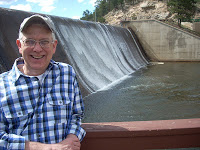Hooves are more a fantasy than a reality for me, the sound of hooves on the ground more a live radio show trick than an experience of being near live horses. I guess that is part of my city life upbringing although our city had the grand population of 20,000 and sat in central Kansas. There were real horses nearby.
I remember my grandfather Schmedemann’s team of horses that pulled the hay wagon during bailing. I sat on Grandpa’s wagons and imagined flipping the reins to make those huge animals pull me, but due to their size, I kept my distance. I remember their stalls in the north end of the stock barn and the leather strips they wore on their backs to keep the flies off while they worked. I don’t recall just when they were no longer around, sometime in my mid-childhood, but I’m sure I learned the phrase “sent to the glue factory” around then. I don’t know if it was at all true. I did like their large hooves and the shoes they wore.
I recall real hoof sounds from horses in hometown parades, the Cheyenne Wyoming Frontier Days in 1959, and other parades and rodeos in following years, right up to Denver’s Pridefest Parade I started watching in 1999.
The only horses I actually rode besides the pony in a pony ring at an Estes Park resort were likewise in Colorado years apart, two trail rides. The first when I was a teenager I recall in vivid detail. The trail master shouted, “Pull your reins to the right,” to us not long after we’d begun the climb above the Big Thompson River. I didn’t understand or was too preoccupied with my daydreams not to even have heard him. My horse probably didn’t know that much English or looked to see the trail master. She walked the path several times a day all summer long but that afternoon saw off to our left the small bear that concerned the trail leader. I didn’t know what was going on but remember my horses’ hooves clattering on the rocks as she tried to push ahead of other horses on the trail. That’s when I heard the follow-up command shouted at me. “Hey you, pull your reins to the right,” and to everyone else again, “Don’t let them see the bear.” I did so and finally realized the problem. Both the horse and I were okay. The bear was probably laughing. Of course, I’d never even heard of a laughing bear.
The other ride was with a youth group I led. We were at a resort on Grand Mesa. Most of the kids wanted a trail ride. I joined them and held my very young daughter in my lap. About two minutes into the ride she fell asleep. I held her close to me as we went up and down steep slopes, jerking and jostling with the rhythm of the horse. She slept calmly the whole ride while my arms got very, very tired.
I can still play gallop like we kids did in childhood but I rarely do so these days. My grandkids grew up. I have some great grandkids but don’t know if they will ever want to play horse. Maybe I’ll find out at Christmas.
© 9 October 2017
About the Author
Phillip Hoyle lives in Denver and spends his time writing, painting, and socializing. In general, he keeps busy with groups of writers and artists. Following thirty-two years in church work and fifteen in a therapeutic massage practice, he now focuses on creating beauty. He volunteers at The Center leading the SAGE program “Telling Your Story.”
He also blogs at artandmorebyphilhoyle.blogspot.com

